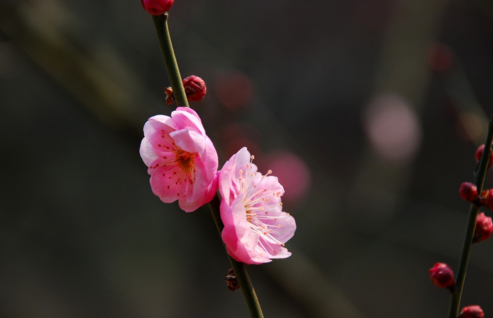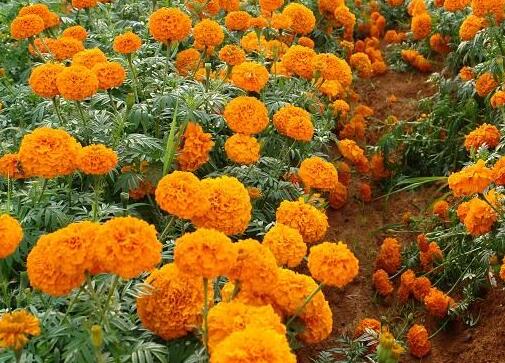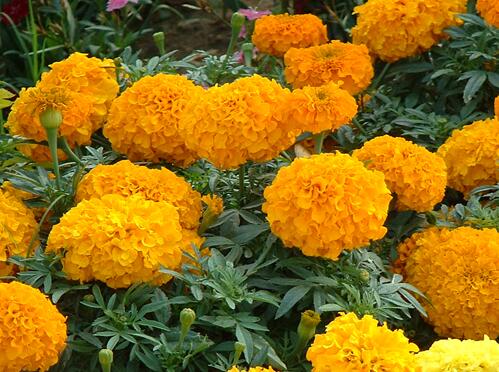What are the flowers blooming in December? how to grow them?
To talk about this December, this is what many people know, cold do not want, plants are also more afraid of the cold, let's take a look at the flowers in December? How to grow flowers in December:

What are the flowers blooming in December:
1. Plum blossom
Which flowers bloom in winter? I believe everyone's first impression is the plum blossom. Lamei is also called yellow plum blossom, fragrant plum and fragrant wood. Lamei has a well-developed root neck, opposite leaves, long oval shape and rough surface. The annual flowering period is from December to February of the following year. The common varieties of wax plum are vegetarian wax plum, Chukou wax plum, small flower wax plum and dog claw plum.
Li Zhong, a traditional Chinese medicine expert in the Ming Dynasty, recorded the efficacy of plum blossoms in his book "Materia Medica primitive he Lei Public processing" (also known as "Materia Medica primitive"): "clear the head, benefit lung qi, remove phlegm and stagnate heat." Modern medical research has also confirmed that plum blossom buds contain volatile oil, mainly benzaldehyde, isoeugenol, benzoic acid, promote gastrointestinal peristalsis, increase appetite, help digestion, and have a certain effect on stomach; at the same time, it has an inhibitory effect on a variety of bacteria and is a good medicine and food.
2. Camellia
Camellia, also known as Camellia, belongs to the genus Camellia of Theaceae. Camellia flower is one of the top ten famous flowers in Chinese tradition because of its rich appearance and dignified elegance. The florescence varies with different varieties, with flowers blooming from October to April of the following year. Camellia is used as cosmetics to smooth and tender the skin and remove spots.
Camellia is non-toxic, and the petals are rich in a variety of vitamins, protein, fat, starch and various trace minerals and other nutrients, which can strengthen the spleen and appetizer and treat diseases such as dysentery. It is a kind of natural food and has deep health care significance.
3. A string of red
A string of red, some also called under the wall red, this is a Labiatae plant, the main flowering period is from December to May of the following year. The flower is in the shape of a small long tube, red and warm in color. When the flower blooms, it looks like a string of red firecrackers, so it is also known as firecracker red. A string of red there are many varieties, colors are also rich, pink and white, red and white and blue-white, purple-white and other colors to join, so that the living environment is more elegant and chic.
A bunch of red whole herbs can be used as medicine, can be harvested during the growing period, fresh or dried. It has the effects of clearing heat, cooling blood, detumescence and so on. It can be used to treat furuncle. At the beginning of eczema, you can apply a proper amount of fresh red to external application.
4. Mo Lan
Chinese orchid, also known as Chinese orchid, geophyte, 3-5 leaves, dark green, the color of flowers vary greatly, more often for dark purple or purple brown and light lip, but also yellowish green, peach or white, generally have a strong aroma, florescence from October to March of the following year. Prefer yin to strong light.
When Mulan is placed at home, it should be noted that the environment should be ventilated in summer, and it does not matter if the temperature is slightly lower in winter. The ink likes the air circulation environment, carries on the ventilation when the relative humidity is too low, had better spray water at the same time, this helps to increase the air humidity and prevent the leaves from being at the tip.
5. Gentleman's orchid
Cymbidium is a perennial herb of the genus Amaryllidaceae, which is elegant and handsome, elegant and elegant, with flowers such as orchids, and gets its name. The florescence is as long as 30-50 days, mainly in winter and spring, and New Year's Day also opens around the Spring Festival.
The magnolia plant, especially the broad and thick leaves, has a lot of stomata and villi, which can secrete a lot of mucus, absorb a lot of dust, dust and harmful gases through air circulation, and filter the indoor air. reduce the dust content in the indoor space and make the air clean. Therefore, the gentleman orchid is praised as the ideal "absorption machine" and "dust collector".
6. Longevity flower
Longevity flower: Narcissus jonquilla L. Crassulaceae, cauliflower plants. Originally from southern Europe. Succulent plant, a low clump of fleshy, shiny leaves that is green all the year round. It is planted in the open ground in spring, summer and autumn as edge material, and blooms brightly from December to April of the next year, with as many as dozens of flowers on each branch. The florescence lasts for more than 4 months, from which the name of longevity flower comes from. It is an ideal potted flower for New Year's Day and his relatives, friends and elders during the Spring Festival.
7. Melon leaf chrysanthemum
Perennial herbs, often cultivated for 1-2 years. Divided into tall and dwarf species, ranging from 20 to 90 cm. The whole plant is covered with micro-hairs, and the leaves are as large as melon leaves, green and bright. The flowers are terminal, the heads are mostly aggregated into corymbs, and the inflorescences are densely covered at the top of the branches, often in the shape of a pot bottom, with rich colors, except yellow, and a red-and-white complex color with a florescence of 1-4 months.
8. Freesia
Leaves linear, hard; flowering in early spring, with yellow, white, purple, red, pink and other colors, spikes, flowers on one side, narrow below the middle of the tube, lobes unequal, fragrant.
9. Chunlan
Also known as Dolan, Pudi Orchid, quiet Orchid, Duodouxiang, Caolan, is one of the most popular species in Chinese orchids, with rich traditional treasures and treasures. Plants are generally small, pseudobulbs globose, and also small. Leaf margin serrulate. There are more than one or two flowers, not out of the shelf; most of the flowers are green and brownish yellow.
10. Larynx grass
Herbs annual, 8-15 cm tall, all white puberulent. The root leaves are clustered, rosette-shaped and laid on the ground with a fine handle; the leaf blade is nearly round, about 15 mm in diameter, the base is slightly heart-shaped, the edge is crenate, green above, and sometimes purplish red locally.
11. Poinsettia
Poinsettia is usually 60 cm to 3 m high and its dark green leaves are about 7 to 16 cm long. The top leaves are fiery red, red or white, so they are often mistaken for flowers, while the real flower is in the middle of the leaf bundle. The florescence lasts from December to February of the following year. The florescence is during the period of Christmas and New Year's Day, which is very suitable for the festive atmosphere. # p# subtitle # e #
How to grow flowers in December:
I. temperature
1. For cold-resistant flowers with low temperature and cold temperature (5-12 ℃, below 5 ℃), such as pomegranate, rose, wax plum, sweet-scented osmanthus, palm, pedicel begonia and crape myrtle, you can put them in the outdoor courtyard or balcony facing the sun.
2. Flowers that need to be kept at medium temperature (12-20 ℃), such as Magnolia, Camellia, Azalea, Michelia, Gentleman, inverted Golden Bell and four Seasons Begonia, must be moved indoors before the temperature drops to 10 ℃.
3, for flowers that can grow normally under high temperature (18-30 ℃), such as Milan, Fusang, jasmine, Cinnamomum mongolicum, daffodils, epiphyllum, lotus, cactus, cactus and aloe, etc., must be moved indoors before the temperature drops to 12 ℃, put the flowerpot in a plastic bag before the temperature drops to 5 ℃, and tie the plastic bag tightly, leaving a small number of pores on the bag to facilitate ventilation. Around noon when the weather is clear and windless, move outside to bask in the sun for a few hours and then move back to the room to keep warm.
2. Pruning
Before overwintering, potted flowers should be pruned in time to reduce nutrient consumption and indoor space during overwintering.
III. Fertilization
Apply fertilizer and water once before overwintering. When overwintering, flowers generally stop fertilizing.
Fourth, watering
Generally, it is necessary to keep the basin soil dry and water less. The watering time in December should be 3 to 4 hours before and after noon, and the water temperature should be basically consistent with the air temperature and soil temperature, so as to avoid adverse reactions caused by low water temperature.
V. ventilation
Pay attention to regular ventilation, preferably when there is a sunny day, or at noon when the temperature is high. When ventilating, we must also pay attention not to let the cold air blow the plant directly, so as to avoid adverse reactions.
VI. The beginning of spring
At the beginning of next spring, generally during the period from the Spring Equinox to the Qingming Festival, overwintering flowers can be moved outdoors and applied with fertilizer and water, such as bio-organic fertilizer, yellow leaves must be treated, trace element water-soluble fertilizer, and so on, so that flowers can grow normally in spring.
VII. Disease and pest control
For flowers and trees that are prone to diseases and insect pests in the leaves of begonia, roses and camellia, collecting and burning the dead branches and leaves under their plants can reduce the occurrence of diseases next year. At the same time, carbendazim was sprayed for sterilization. For Botrytis cinerea of * * disease, rust and primroses, triadimefon or tocopherol can be used to prevent and cure respectively. When there is poor ventilation, aphids often appear on potted plants, such as Magnolia, Milan and so on. Imidacloprid can be used for control. For scale insects, of course, it is necessary to use targeted scale control.
This is the end of the introduction of flowers in December. It is relatively cold in December, but it is necessary to cultivate flowers well.
To understand the seed planting methods of Cymbidium and to learn the essentials of growing flowers is not difficult at all.
Cymbidium itself is a more noble kind of flowers, and the planting conditions of orchids are much higher than those of other flowers. As long as you pay attention to the habits of Magnolia can it be planted well, first of all, on the flowerpot that you choose to plant, many people think that it can be planted in a small pot, but in fact, Magnolia likes large flowerpots instead. It may look small at the beginning of planting, but when you grow up, the roots will be very deep, so choosing a larger pot can put more soil to help you take root.
To choose the right flowerpot is to choose the soil suitable for growth, and many people casually get some loess and put it in the pot. Magnolia needs soft black soil to grow, using very hard loess to take root is very difficult, reducing the survival rate a lot.
Then put the prepared soil in the flowerpot, and then plant the orchid in the flowerpot, not very deep. It is easy to rot the root, just cover it with a little bit of soil, so that the root of the gentleman orchid can slowly go in.
After planting, you have to start watering. You must water the planted orchid for the first time in order to water it thoroughly. Leave it outside for half an hour after watering, so that the water almost permeates. Then put it in a cool ventilated place at the end of the room, and it is more appropriate to keep the temperature at 19 degrees. After about half a month, the magnolia can grow new buds, because the buds are relatively young and should not be exposed to the sun.
In this way, it will be able to blossom normally for about a year and a half, and it will be very beautiful when the orchid blossoms, basically in December when the flowers are blooming. It is very beautiful to watch during the Spring Festival.
Flower cultivation in December it is no longer difficult to grow flowers.
With these tips in mind, it is no longer difficult to grow flowers.
If you can't get out of the house in cold weather in January, you must prevent dry injury caused by dry mud. The pots dry through the mud and leave the shell, and the wonderful section is poured with raw rotten pulp.
There is a slight breeze in February spring, and two or three cups of river water must be watered. The size of the flowerpot should be considered and should not be watered into the pot.
When the spring in March and the sun are warm, the orchid wind is dewy, and although the east wind is all right, the northwest gale should be avoided.
April is really easy to maintain, regardless of thunderstorm, if a long time under the eaves of rain, the wind will not hurt slightly.
In May, the sun is slightly like fire, watering at night and hiding at 03:00 in the morning, and handing in Shen you in the afternoon, the new sprouts will not be hurt.
June inflammation in the morning and evening watering, root through the launch of new seedlings, if still thin how to treat, secretly teach immortal milk.
At the beginning of July, the Beginning of Autumn, the new root is growing. If you see the root knot in the basin, you should also use your fingertips to loosen the soil.
In August, the Mid-Autumn Festival frost is thick, it is necessary to fill the basin with grass juice, strong roots and leaves, strong autumn grains, but also new flowers will be different.
The wind in Chongyang is getting colder in September, and the mud noodles in the basin should not be dry. I advise you to sprinkle more and more dew, as there are new grains of soil.
It is cold and hot in small spring in October, beware of wind, rain and frost, the weather should be exposed to the window, and the cold should be kept warm in the house.
Son month cold days do not leave the house, mild but also close the wind window, the most suitable loose? Spread potted noodles, otherwise the cotton will be good.
The window is closed in December, the silver jar is extremely cold and frozen, and the basin is dry and slightly watered. Do not get hurt when you hook it on all sides.
- Prev

Sharing of planting methods and points for attention of marigold
The suitable temperature for the growth of marigold is 15-25 ℃, and the suitable temperature for flowering is 18-20 ℃. The relative air temperature of the growing environment is required to be 60-70%, and the winter temperature is not lower than 5 ℃. When the high temperature in summer is more than 30 ℃, the plant is overgrown, the stem and leaf are loose, and the flowering is few. Under 10 ℃, the growth slows down
- Next

Propagation methods of marigold sowing propagation and cutting propagation
Marigold can be cut in summer, which is easy to root and grow into seedlings quickly. Cut 8-12 cm twigs from the mother plant as cuttings, remove the lower leaves, insert them into the basin soil, insert 3 plants in each pot, pour enough water after insertion, slightly shade, and root after 2 weeks. Then, gradually move to a sunny place for daily management.
Related
- Fuxing push coffee new agricultural production and marketing class: lack of small-scale processing plants
- Jujube rice field leisure farm deep ploughing Yilan for five years to create a space for organic food and play
- Nongyu Farm-A trial of organic papaya for brave women with advanced technology
- Four points for attention in the prevention and control of diseases and insect pests of edible fungi
- How to add nutrient solution to Edible Fungi
- Is there any good way to control edible fungus mites?
- Open Inoculation Technology of Edible Fungi
- Is there any clever way to use fertilizer for edible fungus in winter?
- What agents are used to kill the pathogens of edible fungi in the mushroom shed?
- Rapid drying of Edible Fungi

